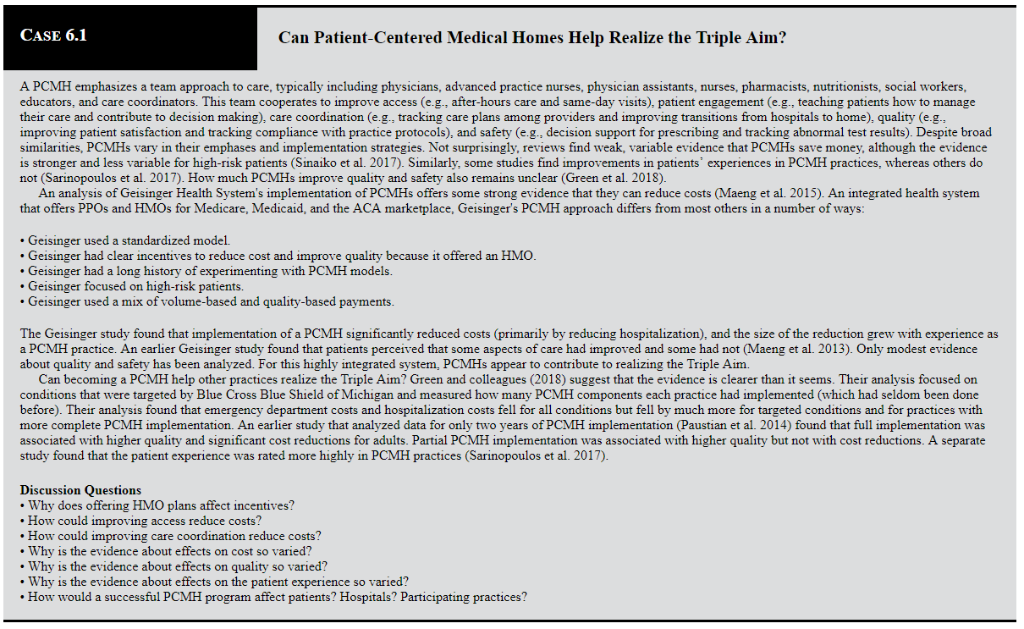
- Why does offering HMO plans affect incentives?
- How could improving access reduce costs?
- How could improving care coordination reduce costs?
- Why is the evidence about effects on cost so varied?
- Why is the evidence about effects on quality so varied?
- Why is the evidence about effects on the patient experience so varied?:
- How would a successful PCMH program affect patients? Hospitals? Participating practices?
CASE 6.1 Can Patient-Centered Medical Homes Help Realize the Triple Aim? A PCMH emphasizes a team approach to care, typically including physicians, advanced practice nurses, physician assistants, mnurses, pharmacists, nutritionists, social workers, educators, and care coordinators. This team cooperates to improve access (e.g., after-hours care and same-day visits), patient engagement (e.g., teaching patients how to manage their care and contribute to decision making), care coordination (e.g, tracking care plans among providers and improving transitions from hospitals to home), quality (e.g improving patient satisfaction and tracking compliance with practice protocols), and safety (e.g, decision support for prescribing and tracking abnormal test results). Despite broad similarities, PCMHs vary in their emphases and implementation strategies. Not surprisingly, reviews find weak, variable evidence that PCMHs save money, although the evidence is stronger and less variable for high-risk patients (Sinaiko et al. 2017). Similarly, some studies find improvements in patients' experiences in PCMH practices, whereas others do not (Sarinopoulos et al. 2017). How much PCMHs improve quality and safety also remains unclear (Green et al. 2018) nce that they ucosts (aeng et al 2015). of ways s offers some strong An analysis of MOS for Medicare Madicaid and the ACA marketplace, Geisinger's PCMH approach differs from most others in a numbernintegrated health system that offers PPOS and Geisinger used a standardized model. Geis Geisinger had a long history of experimenting with PCMH models Geisinger focused on high-risk patients. Geisinger used a mix of volume-based and quality-based payments. had clear incentives to reduce cost and improve quality because it offered an HMO. The Geisinger study found that implementation of a PCMH significantly reduced costs (primarily by reducing hospitalization), and the size of the reduction grew with experience as a PCMH practice. An earlier Geisinger study found that patients perceived that some aspects of care had improved and some had not (Maeng et al. 2013). Only modest evidence about quality and safety has been analyzed. For this highly integrated system, PCMHs appear to contribute Can becoming a PCMH help other practices realize the Triple Aim? Green and colleagues (2018) suggest that the evidence is clearer than it seems. Their analysis focused on conditions that were targeted by Blue Cross Blue Shield of Michigan and measured how many PCMH components each practice had implemented (which had seldom been done before). Their analysis found that emergency department costs and hospitalization costs fell for all conditions but fell by much more for targeted conditions and for practices with more complete PCMH implementation. An earlier study that analyzed data for only two years of PCMH implementation (Paustian associated with higher quality and significant cost reductions for adults. Partial PCMH implementation was associated with higher quality but not with cost reductions. A separate study found that the patient experience was rated more highly in PCMH practices (Sarinopoulos et al. 2017). realizing the Triple Aim tal. 2014) found that full implementation was Discussion Questions Why does offering HMO plans affect incentives? How could improving access reduce costs? How could improving care coordination reduce costs? Why is the evidence about effects on cost so varied? Why is the evidence about effects on quality so varied? . Why is the evidence about effects on the patient experience so varied? How would a successful PCMH program affect patients? Hospitals? Participating practices? CASE 6.1 Can Patient-Centered Medical Homes Help Realize the Triple Aim? A PCMH emphasizes a team approach to care, typically including physicians, advanced practice nurses, physician assistants, mnurses, pharmacists, nutritionists, social workers, educators, and care coordinators. This team cooperates to improve access (e.g., after-hours care and same-day visits), patient engagement (e.g., teaching patients how to manage their care and contribute to decision making), care coordination (e.g, tracking care plans among providers and improving transitions from hospitals to home), quality (e.g improving patient satisfaction and tracking compliance with practice protocols), and safety (e.g, decision support for prescribing and tracking abnormal test results). Despite broad similarities, PCMHs vary in their emphases and implementation strategies. Not surprisingly, reviews find weak, variable evidence that PCMHs save money, although the evidence is stronger and less variable for high-risk patients (Sinaiko et al. 2017). Similarly, some studies find improvements in patients' experiences in PCMH practices, whereas others do not (Sarinopoulos et al. 2017). How much PCMHs improve quality and safety also remains unclear (Green et al. 2018) nce that they ucosts (aeng et al 2015). of ways s offers some strong An analysis of MOS for Medicare Madicaid and the ACA marketplace, Geisinger's PCMH approach differs from most others in a numbernintegrated health system that offers PPOS and Geisinger used a standardized model. Geis Geisinger had a long history of experimenting with PCMH models Geisinger focused on high-risk patients. Geisinger used a mix of volume-based and quality-based payments. had clear incentives to reduce cost and improve quality because it offered an HMO. The Geisinger study found that implementation of a PCMH significantly reduced costs (primarily by reducing hospitalization), and the size of the reduction grew with experience as a PCMH practice. An earlier Geisinger study found that patients perceived that some aspects of care had improved and some had not (Maeng et al. 2013). Only modest evidence about quality and safety has been analyzed. For this highly integrated system, PCMHs appear to contribute Can becoming a PCMH help other practices realize the Triple Aim? Green and colleagues (2018) suggest that the evidence is clearer than it seems. Their analysis focused on conditions that were targeted by Blue Cross Blue Shield of Michigan and measured how many PCMH components each practice had implemented (which had seldom been done before). Their analysis found that emergency department costs and hospitalization costs fell for all conditions but fell by much more for targeted conditions and for practices with more complete PCMH implementation. An earlier study that analyzed data for only two years of PCMH implementation (Paustian associated with higher quality and significant cost reductions for adults. Partial PCMH implementation was associated with higher quality but not with cost reductions. A separate study found that the patient experience was rated more highly in PCMH practices (Sarinopoulos et al. 2017). realizing the Triple Aim tal. 2014) found that full implementation was Discussion Questions Why does offering HMO plans affect incentives? How could improving access reduce costs? How could improving care coordination reduce costs? Why is the evidence about effects on cost so varied? Why is the evidence about effects on quality so varied? . Why is the evidence about effects on the patient experience so varied? How would a successful PCMH program affect patients? Hospitals? Participating practices







